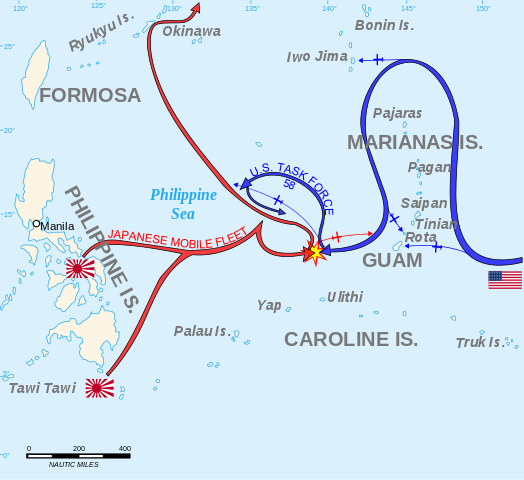
The Great Marianas Turkey Shoot
19 June 1944

In the largest carrier-to-carrier battle in history, the U.S. Navy decimated the Japanese Naval Air Forces in the decisive Battle of the Philippine Sea on 19-20 June 1944, which many have called the turning point of the war in the Pacific.
During his flight debrief, USS Lexington-based pilot Ens. Ziggy Neff, who splashed four Japanese planes in his only combat action, famously exclaimed, "Hell, it was just like an old-time turkey shoot home back home in Missouri!" And ever since, the aerial combat portion of the Battle of the Philippine Sea has been known in U.S. naval aviation circles as The Great Marianas Turkey Shoot.
During the course of the battle, the Japanese launched four separate aerial attacks. Of 373 carrier-based aircraft launched, only 130 returned. Many of them were destroyed later, when their carriers, Taiho and Shokaku, were sunk by U.S. submarines on the first day of battle. After the second day of the battle, Japan's losses totaled three carriers, more than 433 carrier aircraft, and roughly 200 land-based aircraft.
In stark contrast, the Americans lost only 23 aircraft on the first day of the battle. On Day Two, 215 U.S. aircraft launched, but only 115 made it back to the carriers. Twenty were lost due to enemy action, but 80 more were lost when they ran out of fuel and had to ditch in the sea short of the carrier. Most of those air crews (about three-quarters) were rescued from the sea over the next few days.
The Japanese fleet's air arm was already significantly outnumbered, and it was impossible to recover from the losses suffered in this one decisive battle. It had taken Japan almost a year to reconstitute its carrier air groups after earlier carrier battles at Coral Sea and Midway, followed by the lengthy Solomon Islands and Guadalcanal campaigns, and the American fleet had destroyed 90% of it in just two days.
The vast majority of Japan's trained and experienced pilots had been lost, and there were only enough left to man one air group for one of its light carriers. The Japanese naval air arm was destroyed by superior American numbers, training and experience, and four months later, at the Battle of Leyte Gulf, two of the remaining Japanese carriers were used solely as decoys.
Unbelievable Numbers
 Image credit: historicair, via Wikimedia Commons
Image credit: historicair, via Wikimedia CommonsThis map shows the area and the locations and movements of the American and Japanese fleets during the Battle of the Philippine Sea. Imagine that in and over those waters, on those two days, there were 219 ships and over 1700 aircraft!
In the American fleet, there were:
7 fleet carriers
8 light fleet carriers
7 battleships
8 heavy cruisers
13 light cruisers
58 destroyers
28 submarines
956 carrier-based aircraft
The Japanese fleet consisted of:
5 fleet carriers
4 light carriers
5 battleships
13 heavy cruisers
6 light cruisers
27 destroyers
24 submarines
6 oilers
~450 Japanese carrier-based aircraft
~300 Japanese land-based aircraft
It's hard to imagine there was manuevering room for more than 200 ships and submarines! But there is a huge expanse of ocean in the Philippine Sea. The distance between Guam and the Philippines is about 1500 nautical miles. (Roughly the distance from Los Angeles to Memphis, or from Chicago to Las Vegas.)
This decisive American victory in the Battle of the Philippine Sea turned the tide of battle in the Pacific in 1944.

More about the battles in the Pacific during WWII:





If you didn't find what you're looking for, use the search bar below to search the site:



New! Comments
Join our conversation! Leave me a comment about this page in the box below. If your comment is about another page on this site, please leave your comment on that page, because I have no ability to move it to the correct page. Thanks!